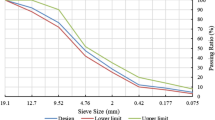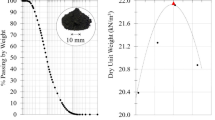Abstract
With the performance limitation of a conventional hot-mix asphalt mixture, the structural integrity of that is highly needed to be enhanced to increase the fatigue life of the mixture. Various geosynthetic alternatives have been widely utilized, such as geogrid, geotextile, or geomembrane layers at the bottom the mixture or on the top of a subgrade to improve the structural integrity of a hot-mix asphalt pavement system. Although reinforcing effects of such interlayers has been reported with some improvements in hot-mix asphalt pavements’ performances, such as mitigating rut or delaying reflective cracks; however, such alternatives do not enhance toughness, tensile strength, or shear strength of the hot-mix asphalt mixture itself due to that the interlayers are usually installed in between two layers in a pavement system and those interlayers do not mix with hot-mix asphalt mixtures. A new plastic fiber-reinforced hot-mix asphalt mixture was proposed in this study to provide more enhanced structural integrity of the mixture not only at the bottom of the mixture but also within the mixture. The developed mixture in this study led to significant enhancements in phenomenological toughness and fatigue life of that at least 1.5 times higher than those for conventional hot-mix asphalt mixtures as resulting from indirect cyclic fatigue tests in loading-control modes and four-point bending beam tests in displacement-control modes.
Similar content being viewed by others
References
Agostinacchio, M. and Cuomo, G. (2004). “Asphalt concrete pavement reinforcement through the addition of micro-fibers and steel meshes.” 4th International SIIV Congress, Palermo, Italy, pp. 1–12.
Al-Qadi, I. L., Buttlar, W. G., Baek, J., and Kim, M. (2009). Cost effectiveness and performance of overlay systems in illinois, Vol. 1: Effectiveness assessment of HMA overlay interlay systems used to retarded reflective cracking, Research Report No. ICT-09-044, Illinois Center for Transportation, UIUC, Urbana, IL, USA.
Al-Qadi, I. L., Reubush Diefenderfer, S., and Loulizi, A. (2005). Fatigue life characterization of superpave mixtures at the virginia smart road, Final Contract Report No. FHWA/VTRC 06-CR1, Charlottesville, VA, USA.
Brule, B. (1996). “Polymer modified asphalt cements used in the road construction industry: Basic principles.” TRR 1535, TRB, National Research Council, Washington, D. C., pp. 48–53.
Bueno, B. S., Silva, W. R., Lima, D. C., and Minete, E. (2003). “Engineering properties of fiber-reinforced cold asphalt mixes.” J. Environmental Engrg., ASCE, Vol. 129, No. 10.
Buttlar, W. G., Roque, R., and Reid, B. (1998). “An automated procedure for generation of the creep compliance master curve for asphalt mixtures.” TRR 1630, TRB, National Research Council, Washington, D. C., pp. 28–36.
Elseifi, M. A. (1999). Viscoelastic modeling of straight and modified binders at intermediate and high temperatures, Master’s Thesis, Virginia Tech, Balcksburg, VA, USA.
Elseifi, M. A., Al-Qadi, I. L., and Yoo, P. J. (2006). “Viscoelastic modeling and field validation of flexible pavements.” J. Engrg Mechs, ASCE Vol. 132, No. 2, pp. 172–178.
Kaloush, K. E., Biligiri, K. P., and Zeiada, W. A. (2008). Evaluation of FORTA fiber-reinforced asphalt mixtures using advanced material characterization tests-Evergreen drive, Tampa, Arizona, Research Report, FORTA Corporation, Grove City, PA, USA.
Lee, S. J., Rust, J. P., Hamouda, H., Kim, Y. R., and Bordon, R. H. (2005). “Fatigue cracking resistance of fiber-reinforced asphalt concrete.” Textile Research J., Vol. 75, No. 2, pp. 123–128.
Park, S. W. and Schapery, R. A. (1999). “Methods of interconversion between linear viscoelastic material functions. Part I-A numerical method based on Prony series.” J. of Solids and Structures, Vol. 36, No. 11, pp. 1653–1675.
Roque, R. and Buttlar, W. G. (1992). “Development of a measurement and analysis system to accurately determine asphalt concrete properties using the indirect tensile test.” J. AAPT, Vol. 61, pp. 304–332.
Shen, S. and Carpenter, S. H. (2005). “Application of dissipated energy concept in fatigue endurance limit testing.” TRR 1929, TRB, National Research Council, Washington, D.C., pp. 165–173.
Strategic Highway Research Program. (1994). Binder characterization and evaluation, Vol. 1, SHRP-A-367, National Research Council, Washington, D.C.
Trottier, J. F. and Banthia, N. (1994). “Toughness characterization of fiber-reinforced concrete.” J. of Materials in Civil Engrg., Vol. 6, No. 2, pp. 264–289.
Author information
Authors and Affiliations
Corresponding author
Rights and permissions
About this article
Cite this article
Yoo, P.J., Ohm, B.S. & Choi, J.Y. Toughening characteristics of plastic fiber-reinforced hot-mix asphalt mixtures. KSCE J Civ Eng 16, 751–758 (2012). https://doi.org/10.1007/s12205-012-1384-0
Received:
Revised:
Accepted:
Published:
Issue Date:
DOI: https://doi.org/10.1007/s12205-012-1384-0




